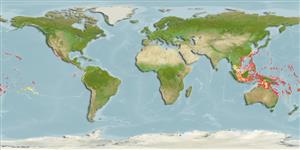>
Gobiiformes (Gobies) >
Gobiidae (Gobies) > Gobiinae
Etymology: Eviota: No etymology given, suggested by Christopher Scharpt: from Latin 'eu' for 'true' and 'iota' for anything very small, in combination 'truly very small' referring to it as being the smallest vertebrate at the time it has benn described by Jenkins (thus, making the suggestion by Scharpt plausible..
More on authors: Jordan & Seale.
Environment: milieu / climate zone / depth range / distribution range
Ecologia
marino associati a barriera corallina; distribuzione batimetrica 0 - 40 m (Ref. 107299). Tropical; 30°N - 30°S
Western Pacific: Japan (Ryukyu and Ogasawara islands), Taiwan, the Philippines and south to Australia and Norfolk Is.; east to Vanuatu, Fiji, Wallis and Futuna, Tonga and Samoa, including Palau, Guam and Marshall Islands in Micronesia.
Size / Peso / Age
Maturity: Lm ? range ? - ? cm
Max length : 2.3 cm SL maschio/sesso non determinato; (Ref. 1602)
Short description
Chiavi di identificazione | Morfologia | Morfometria
Spine dorsali (totale) : 7; Raggi dorsali molli (totale) : 8 - 9; Spine anali: 1; Raggi anali molli: 7 - 8. This species is distinguished by the following characters: complete cephalic sensory-canal pore system (pattern 1); the fifth pelvic-fin ray 10-40% (usually 20%) of fourth ray; some pectoral-fin rays are branched; dorsal/anal-fin formula 9/8; presence of a prominent occipital spot; dorsal midline of body with a series of small dark spots along the dorsal-fin bases; dark bars present crossing the nape in advance of dorsal fin; caudal-peduncle depth 13.4-14.9% SL (Ref. 107299).
Inhabits shallow waters, often including tide pools of exposed seaward reefs (Ref. 37816, 116739), usually in high-tide splash zones and at shallow depths (Ref. 107299).
Life cycle and mating behavior
Maturities | Riproduzione | Spawnings | Egg(s) | Fecundities | Larve
Myers, R.F., 1991. Micronesian reef fishes. Second Ed. Coral Graphics, Barrigada, Guam. 298 p. (Ref. 1602)
IUCN Red List Status (Ref. 130435)
Threat to humans
Harmless
Human uses
Pesca: di nessun interesse
Strumenti
Special reports
Download XML
Fonti Internet
Estimates based on models
Preferred temperature (Ref.
123201): 24.7 - 29.3, mean 28.3 °C (based on 1537 cells).
Phylogenetic diversity index (Ref.
82804): PD
50 = 0.5000 [Uniqueness, from 0.5 = low to 2.0 = high].
Bayesian length-weight: a=0.01023 (0.00477 - 0.02194), b=3.02 (2.84 - 3.20), in cm total length, based on LWR estimates for this (Sub)family-body shape (Ref.
93245).
Trophic level (Ref.
69278): 3.1 ±0.3 se; based on size and trophs of closest relatives
Resilienza (Ref.
120179): Alto, tempo minimo di raddoppiamento della popolazione meno di 15 mesi (Preliminary K or Fecundity.).
Fishing Vulnerability (Ref.
59153): Low vulnerability (10 of 100).
Nutrients (Ref.
124155): Calcium = 374 [160, 1,182] mg/100g; Iron = 1.74 [0.76, 3.78] mg/100g; Protein = 18 [16, 20] %; Omega3 = 0.175 [0.057, 0.516] g/100g; Selenium = 33.1 [10.6, 89.5] μg/100g; VitaminA = 121 [25, 572] μg/100g; Zinc = 4.49 [2.47, 7.46] mg/100g (wet weight);
